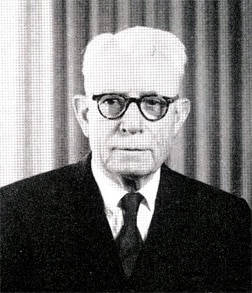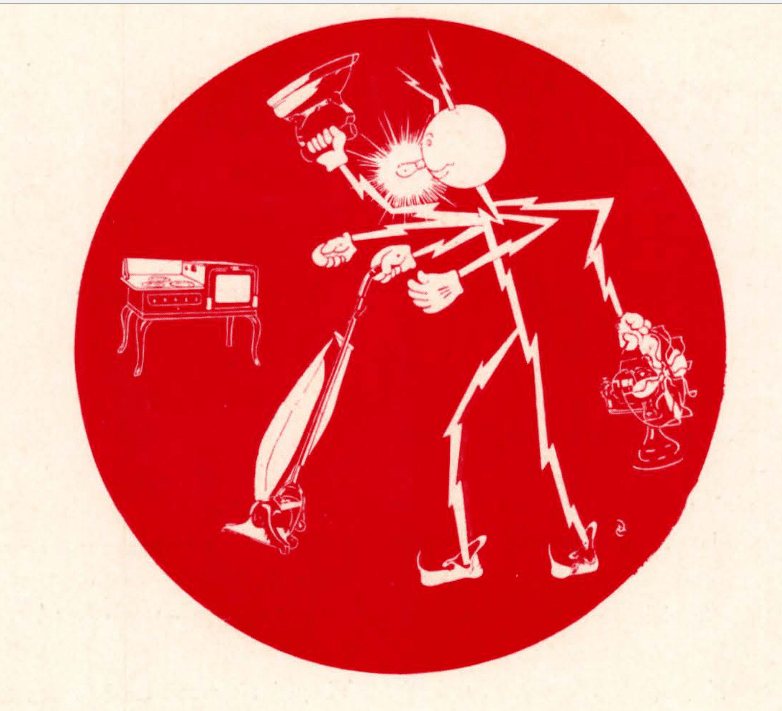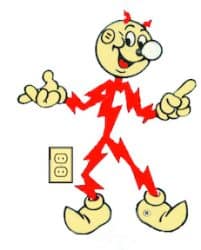Longtime electric industry ‘spokesman’ Reddy Kilowatt got his start at Alabama Power

Reddy Kilowatt in an advertisement on a Birmingham bus in the 1950s. (Alabama Power Archives)
Reddy Kilowatt was born in Alabama.
A cartoon character that ultimately became the “spokesman” for more than 300 electric utilities in the United States and abroad, Reddy was the most recognized trade symbol of the electric industry for more than half a century. His first appearance was in a 1926 advertisement for Alabama Power in The Birmingham News. This year is the 90th anniversary of Reddy being patented by the government and his breakout out as a national and international symbol for the electric industry.

Ashton B. Collins Sr., the creator of Reddy Kilowatt. (National Museum of American History)
Reddy was the brainchild of Ashton B. Collins Sr., then an assistant commercial manager for Alabama Power. At the time, the company was concerned with bringing electricity to rural areas and, as historian Leah Rawls Atkins wrote in her 2006 history of Alabama Power, finding “ways to sell appliances to a public that was still uneasy about the use of electricity.” In a meeting early in 1926, Collins was tasked with creating a display that would help accomplish those objectives, beginning at the Alabama Electrical Exposition, an event he was organizing in his capacity as president of the Alabama Electrical League.
Returning to his office after the meeting, Collins became engrossed by a powerful thunderstorm that was rolling through Birmingham. Watching the lightning flash and intersect on its way to the ground, Collins saw what looked to him like a stick figure of a man. Inspired, he sat down and sketched an image of a figure with arms, legs, and a body of lightning bolts. To help develop his concept, he turned to company engineer Dan Clinton, who produced the first finished drawings of Reddy Kilowatt, giving him a round head with a light bulb for a nose, wall sockets for ears, and a pair of safety gloves.
As planned, Reddy made his debut at the exposition in March 1926. According to a front-page story in the News, the event drew 10,000 people to Birmingham’s Municipal (now Boutwell) Auditorium, where they viewed exhibits by 55 companies “presenting to Alabama housewives, and business and industrial men the latest improvements in labor and time-saving electrically operated devices.”

Reddy Kilowatt, “Your Electrical Servant,” as he appeared in the October 1926 issue of Powergrams. (Alabama Power Archives)
Reddy was introduced in a separate story, under the headline “Reddy’s Many Hands Incline To Make Light Work.” In the illustration by Collins, the character had five lightning-bolt arms, as he still did that October, when featured in Alabama Power’s monthly employee magazine, Powergrams, where he held an iron, a vacuum cleaner, and an electric fan, with an electric stove in the background. Later, to “humanize” the character a bit more, Reddy became a two-armed figure.
As Alabama Power had hoped, the character was a hit with the public. As Atkins noted, Reddy represented the company “on billboards, stationery, advertisements, and giveaway merchandise like pins, earrings, lighters, and hats,” as well as other items. He appeared in ads with holiday recipes. At Halloween, children dressed in Reddy Kilowatt costumes.
For seven years, Reddy represented Alabama Power exclusively. Then, in 1933, Collins left the company to work for the Edison Electric Institute (EEI), an organization that continues to represent investor-owned electric utilities across the nation. Alabama Power allowed Collins to retain the rights to the character, for which he received a U.S. patent later that year.
Collins set off around the country promoting electrical energy on behalf of EEI. Through his company, Reddy Kilowatt Service (later changed to Reddy Kilowatt Inc., or RKI), he also began licensing Reddy for use by electric companies in other countries. The character underwent one more redesign in 1946, this one by the creator of the popular Woody Woodpecker cartoon, Walter Lantz. For decades afterward, Reddy continued to prove as popular around the world as he had been when introduced by Alabama Power.

Reddy as redesigned by “Woody Woodpecker” cartoonist Walter Lantz (Xcel Energy)
Collins stepped down as president of RKI in 1962, handing leadership of the company to his son, Ashton Jr. Collins remained its chairman of the board until his death in 1976, at the age of 91. By that time, with the increasing emphasis on conservation and other changes in the electric industry — as well as the general trend by corporations away from the use of animated characters as spokespersons — many companies were phasing out the use of Reddy, though he remained in use by a small number of companies through the late 1990s. Rights to the character were acquired from RKI in 1998 by Minnesota-based Northern States Power Company, now a subsidiary of Xcel Energy.
Today, particularly to people of a certain age, Reddy Kilowatt remains a figure of fond nostalgia. A quick search on the website of e-commerce company eBay shows more than 800 items featuring Reddy for sale, including plates, clocks, coffee cups, lapel pins, cufflinks, and many others, underscoring the Alabama-born character’s status as an enduring piece of Americana.





